UFO expert’s surprising verdict on 2ft ‘alien’ mummies found in Peru
<!–
<!–
<!– <!–
<!–
(function (src, d, tag){
var s = d.createElement(tag), prev = d.getElementsByTagName(tag)[0];
s.src = src;
prev.parentNode.insertBefore(s, prev);
}(“https://www.dailymail.co.uk/static/gunther/1.17.0/async_bundle–.js”, document, “script”));
<!–
DM.loadCSS(“https://www.dailymail.co.uk/static/gunther/gunther-2159/video_bundle–.css”);
<!–
At first sight it certainly appears to be a creature from outer space.
Any science fiction enthusiast worth their salt knows what an alien looks like: elongated pear-shaped head, three-fingered webbed hands, large, dark eye sockets. Ray gun and silver suit optional.
All are staple features of alien abduction stories and TV shows such as The X Files.
This particular ‘alien’ was apparently recently unearthed from a burial site in South America, in a part of south-western Peru that has become a mecca for those who believe that extra-terrestrials visited Earth thousands of years ago.
Since 2017 at least half a dozen specimens of plaster-encased ‘humanoid mummies’ have come to light, all in mysterious circumstances.
The latest was presented to the world in March amid much fanfare: an eerie, apparently fossilised, humanoid figure, curled into a foetal position, with the prerequisite three fingers and dome-shaped head.
Then, last month, it was claimed that fingerprint and DNA analysis had been done on the creature, supporting the theory that it’s no relative of ours.
The alleged site of the ‘find’ – the Nazca region of Peru – adds to the growing mystique. Nazca is famous for its ‘lines’ – 800 miles of mysterious, patterned grooves that were carved into the desert soil 2,000 years ago by persons, and for reasons, unknown.
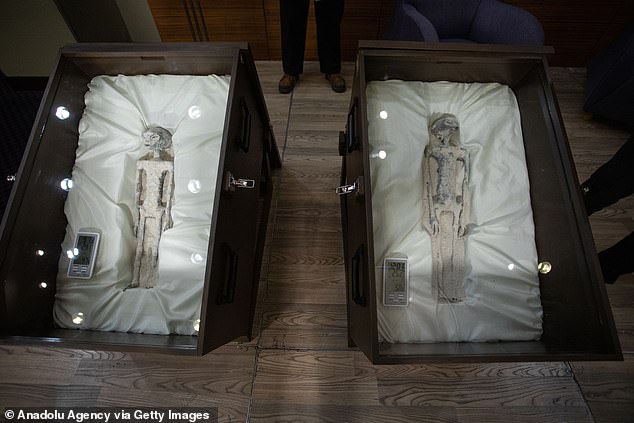
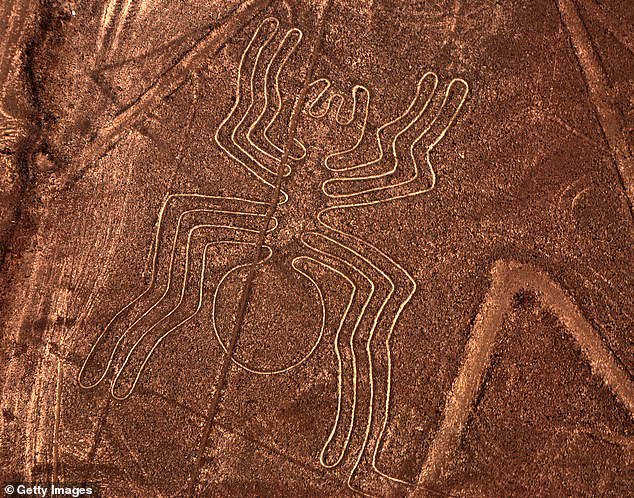
These are the lines that, during the 1960s, writer Erich von Daniken seized upon with his theory that they were the work of ancient astronauts who visited Earth thousands of years ago and changed the course of human history.
Von Daniken, a convicted Swiss fraudster who wrote much of his work in prison while serving time for embezzlement, said the Nazca lines were actually landing strips for UFOs – an extraterrestrial airport, if you like.
This theory, among others, was included in his seminal book – Chariots Of The Gods? – which was published in 1968, the year before the Apollo moon landings, and caused a global sensation with its provocative subtitle ‘Was God an astronaut?’.
Now 89, his books have sold more than 60 million copies worldwide and inspired the hit US TV show Ancient Aliens, launched in 2009 and now in its 20th season.
But despite being debunked and dismissed as ‘pseudoscience’, von Daniken’s ideas still continue to fascinate people today.
Little wonder this raft of so-called ‘alien mummy’ discoveries have created such a stir, gripping the imaginations of not just die-hard UFO believers but also lawyers, historians and scientists across the world, convincing many that we are not alone in the universe and, more intriguingly, that we have had visitors from other planets.
As a teenager, I devoured von Daniken’s books and was hooked on the 1980s ITV show Arthur C. Clarke’s Mysterious World. I can still recall the thrilling opening bars of its dramatic overture music, and that giant crystal skull filling the TV screen.


Although I wasn’t old enough to remember the Apollo astronauts landing on the moon, it seemed logical to me that if humans could leave the Earth to explore our solar system, then alien intelligences could have done the journey in reverse.
Today, my interest in all things alien remains undimmed. Now an investigative journalist, university lecturer and committed UFOlogist, I was one of the first investigators allowed access to the Government’s ‘X Files’ when the Ministry of Defence disbanded its UFO desk in 2009.
So do I believe we are, for the first time, gazing upon the mummified corpse of a real-life alien?
Although I remain open-minded about the existence of life elsewhere in the galaxy, I am unconvinced these were visitors from outer space, and, as I can exclusively reveal, it could well be that the idea of alien mummies in the Nazca desert, in fact, all stems back to what would be the longest running April Fool’s joke in history.
Along with everyone else, however, I was transfixed last September when images of two ‘alien mummies’, allegedly found near Nazca, were shown to politicians at a hearing of Mexico’s National Congress and made headlines around the world.
The meeting had been convened for a serious, scientific examination of recent UFO sightings when the event was ambushed by flamboyant Mexican TV personality, Jaime Maussan, who arrived with two boxes, with the supposedly fossilised figures inside.
He claimed the two-foot long creatures were 1,000-year-old ‘non-human beings that are not part of our terrestrial evolution’ and had been discovered in Peru in 2017.
Not everyone in the audience was impressed. Retired US Navy pilot Ryan Graves, who attended the meeting to share his personal experiences, dismissed the revelation as ‘a stunt’ and ‘a huge step backwards for this issue’.

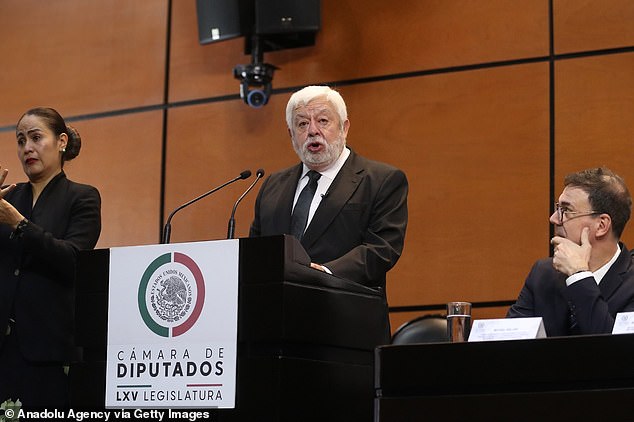
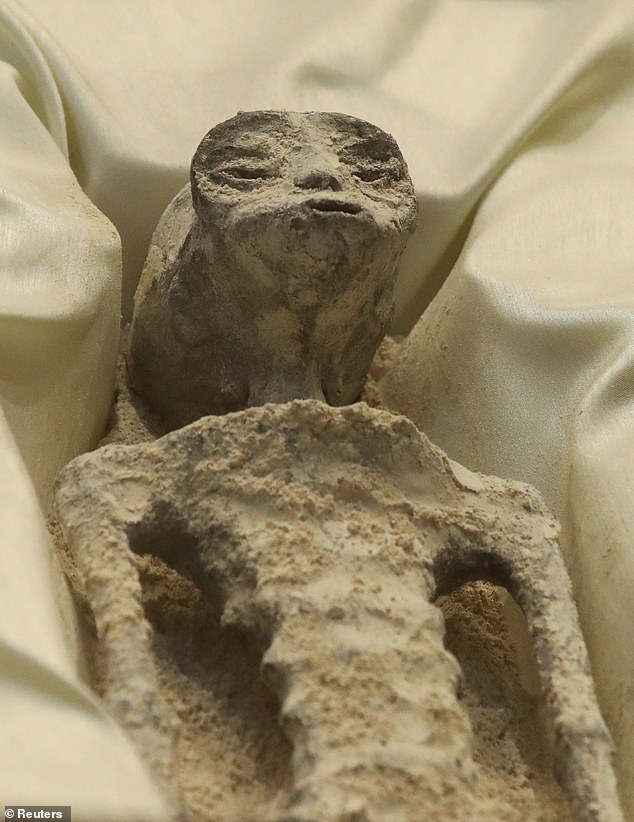
The sensational claims sparked both excitement and scepticism both in the scientific community and in the media.
Leading researchers from Nasa were quizzed about them at a press conference later that month, leading to the eminent astrophysicist David Spergel calling for the samples to be made available to the scientific community for proper scrutiny.
Weeks later, the figures were seized by Peruvian custom officials: if they were from Peru, as claimed, it was unlawful for them to have been dispatched to Mexico. They were in due course examined and – to no one’s surprise – found to be not quite ‘as advertised’.
Flavio Estrada, a forensic archaeologist from the Institute of Legal Medicine and Forensic Sciences of Lima, described them as ‘dolls’ made from animal bones stuck together with modern synthetic glues.
But still the story refused to go away. In March fresh claims surfaced after another set of plaster-encased, three-fingered beings were revealed at a conference staged by two documentary film-makers in West Hollywood, California.
Nicknamed ‘the Nazca mummies’, and again claiming to have been found in this particular area of Peru, these specimens are said to be ‘very different’ to the doll-like creatures paraded around in Mexico.
One is around four-foot long, distinctly humanoid in appearance, and curled into a foetal position.
The film makers, going by the names of Serena DC and her partner Michael Mazzola, claimed to have X-rayed the specimens and subjected them to genetic testing.
‘The DNA is 30 percent unknown,’ said Serena. ‘We’re not saying we found extraterrestrials, but there is a slight chance that it may be from somewhere else in the galaxy. If it was, how cool is that?’
Well, very cool – if the evidence could be independently reviewed, but so far, the specifics remain elusive.
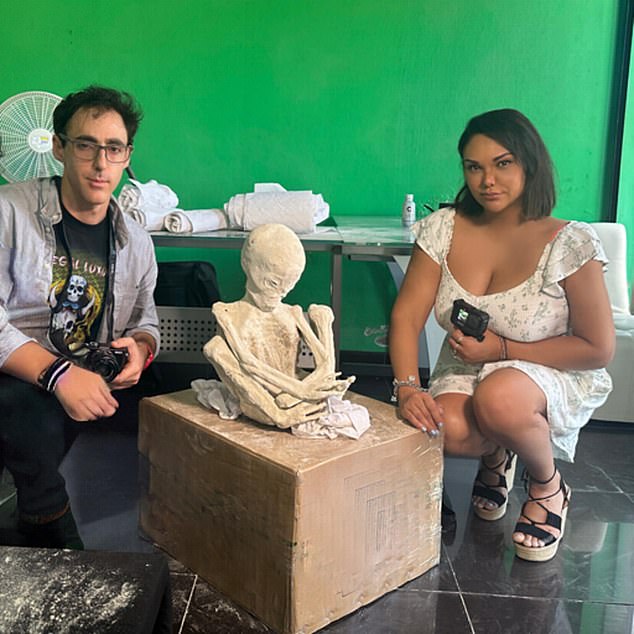
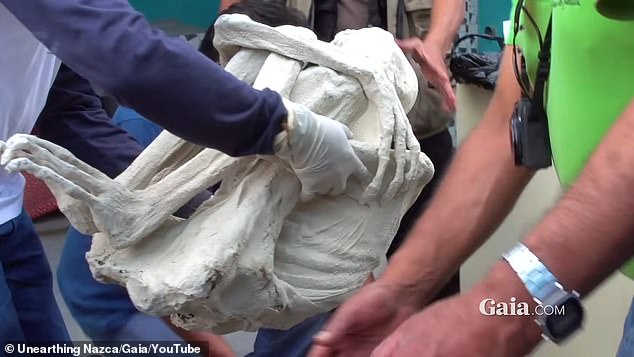
Last month it was claimed the Nazca mummies had been the subject of fresh scrutiny by a team of independent forensic medical examiners from the USA. The team says one, nicknamed ‘Maria’, has fingerprints that matched no known human pattern.
As detailed in every TV detective show, there are three broad types of fingerprints: arches, loops and whorls, unique to every individual. But ‘Maria,’ claimed US attorney Joshua McDowell, appeared to have none of these patterns.
‘We did not see any loops or whorls on the prints of the fingers or on the toes,’ McDowell, a principal at the McDowell Law Firm and one of the team who travelled to Peru to examine the bodies, told the Mail at the time.
‘I’m a former prosecutor. I’m a criminal defense attorney. I’ve seen lots of fingerprints. And these were not classic fingerprints,’ he added. ‘María’s fingerprints weren’t consistent with human prints.’
But McDowell accepts there could be some perfectly natural explanation for the strange ‘friction ridge’ patterns his team found on Maria’s fingers and toes. And he warned it would be ‘extremely premature’ to make any definitive statements about the origin of these mummies.
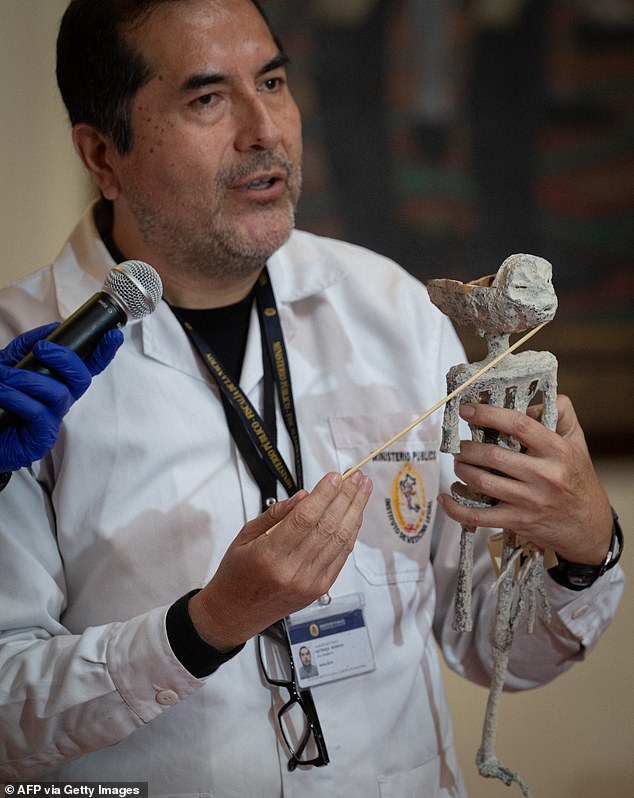
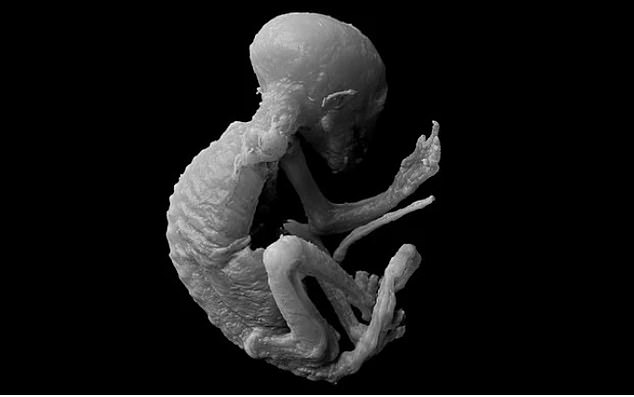
The common thread that links all the recent dubious claims about alien fossils is TV personality Jaime Maussan – the man who ambushed the Mexico UFO conference.
The 71-year-old has been nicknamed the ‘PT Barnum of UFOlogy’, after the notorious 19th Century showman and hoaxer, for his promotion of numerous fake photographs and videos of UFOs and aliens over the years.
One famous example is the ‘Metepec creature’, a small cat-like animal with a large head, supposedly found in a trap by Mexican farmers in 2007. Maussan claimed, on one of his hugely popular TV shows, it was an alien but a Channel 4 investigation found the ‘creature’ was, in fact, nothing more than a skinned monkey.
Then in May 2015 Maussan displayed images of another alleged alien body before a live audience at an event in Mexico City’s National Auditorium.
Several thousand tickets were sold after a YouTube teaser claimed a group of UFO researchers would exclusively reveal two 35mm colour slides of ‘an unusual body in a glass case’.
They claimed it was linked to the famous 1947 ‘UFO crash’ at Roswell in New Mexico, in the US. Roswell has fascinated conspiracy theorists for decades, after a top-secret surveillance balloon, destined for Russia, crashed and the US military desperately tried to cover it up leading to speculation about what had really happened.
The YouTube trailer revealed a glimpse of one image, clearly showing a card with writing on it alongside the remains in the glass case.
The group that promoted the stunt claimed ‘top photographic experts’ had failed to decipher the blurry caption just visible on the card, but sceptics used a clever piece of software to decipher the caption that read: ‘Mummified Body of Two Year Old Boy’.
Inquiries after the event revealed the photo showed the remains of a Native American child, whose remains were excavated in 1894, and donated to the Park Museum in Mesa Verde, Colorado.
It later emerged the slides came from a set of hundreds, taken in the late Forties, and found inside a box that once belonged to a Texas geologist and his wife.
Much like the Nazca mummies, the ‘body’ visible was a desiccated humanoid creature with an elongated head and a small body, resembling the classic ‘grey aliens’ of UFO lore.
Some believe that cranial deformation, in which the pliable skulls of infants were deliberately distorted by binding, is evidence of ET visitations in prehistory. This type of body modification was common in parts of South America and ancient Egypt where it was practised by the pharaohs. As the Egyptians believed their gods descended from the sky, some believe even the pharaohs were alien hybrids.
But all these ideas are based on a lot of assumptions: that if aliens visited Earth in the distant past, our ancestors might have regarded them as gods from the sky, and wanted to mimic them, or were taught by them, to modify their skulls in this way.
That’s an awful lot of ifs and maybes.
English teacher Chris Aubeck, author of a new book, Alien Artifacts, says his research has revealed the current controversy is a repeat of rumours and hoaxes about alien mummies discovered in Peru that can be traced back 160 years. Almost exactly 150 years ago, in 1878, there were press stories about a mummified body that was found by a chemist and his team inside an enormous meteorite in – you guessed it – Peru.

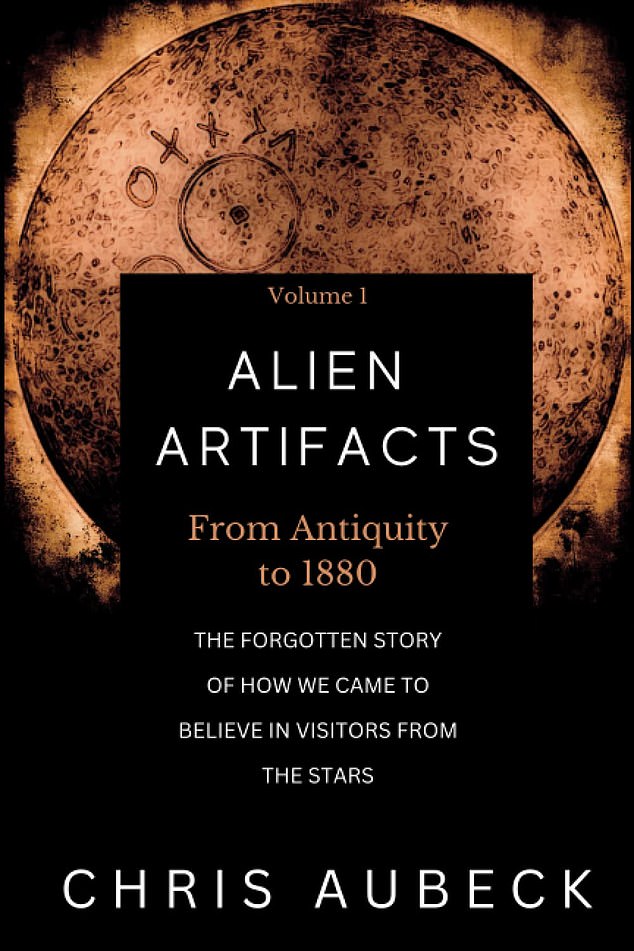
Aubeck says the ‘mummy’ was described in vivid detail: ‘The head was almost intact, it had no hair, the skin was smooth and beardless and looked like tanned leather. Its face was flattened and instead of a nose it had a trunk coming from the forehead and a very small mouth’.
Beside the mummy the excavators claimed to have found a silver plate depicting celestial bodies including Mars and they concluded it was a visitor from the Red Planet.
Mars was big news in 1878 because it was closer to Earth than it had been in 47 years. The previous year, the Italian astronomer Giovanni Schiaperelli observed what he thought were artificial features on the surface of planet.
During his research Aubeck traced the Peruvian story to a newspaper in Argentina that copied it, word for word, from a work of fiction, written by a French mining engineer, Francois-Henri Peudefer de Parville.
De Parville’s novel, An Inhabitant of the Planet Mars, ended with a note admitting it was fiction and there was a big clue in the date of publication: April Fool’s Day, 1864.
‘But this admission did not prevent the story from taking on a life of its own,’ Aubeck said. ‘The journey of this tale from a French newspaper in 1864 to Argentina and then Peru in 1878, and now a new claim in 2024 just shows the enduring appeal of stories about extraterrestrial life.’
Aubeck, 53, says it is difficult to disprove ideas that have been circulating for almost 200 years: ‘When we see architectural wonders, we must remember technical know-how gets lost when empires fall. It’s always been fun to dream of a lost golden past and watch subversive figures like Erich von Daniken try to pick holes in established wisdom.’
Who wouldn’t love to prove their teachers at school were wrong? But 20 seasons of Ancient Aliens have taught us just one thing: this subject is big business.


